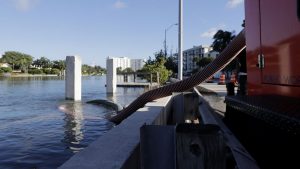The Legislature took a modest but important step to better protect the state from the growing threat of climate change. A new statewide resiliency program will help coastal and inland communities alike harden their defenses against rising seas and other impacts.
While the funding mechanism is not ideal, the effort represents a bipartisan approach to a pressing danger in low-lying Florida.
Senate Bill 1954, approved unanimously by lawmakers in both the House and Senate, creates a two-track strategy for addressing climate change. First, it establishes a grant program to help cities and counties assess the risks that flooding and sea-level rise pose to their critical infrastructure. That would be especially helpful to small and low-income communities that lack the money and expertise to prepare.
The measure would also inventory these threats statewide, and provide up to $100 million annually to protect “critical assets,” from roadways, bridges, water plants and storm sewers to government facilities and wildlife habitat.

A temporary pumping station along the Intracoastal Waterway in Miami Beach. The pumps are intended to help prevent flooding during a king tide. [Lynne Sladky | Associated Press) [ LYNNE SLADKY | AP ]
That underscores the reality that the danger of more severe storms, flooding and rising seas isn’t necessarily contained within city or county boundaries. Taking the larger view is more cost-efficient, and it helps growing metro areas better plan. And the 2023 deadline to complete the statewide assessment of climate risks brings justifiable urgency to the effort.
It would have been better had lawmakers funded the venture without taking the money from Florida’s already hard-hit affordable housing program. The move will shift tens of millions of dollars from an affordable housing trust fund at a time when rising rents and home prices are pushing housing for many Floridians out of reach.
But lawmakers routinely swept hundreds of millions of dollars from the housing fund in recent years. Communities learned to seek federal housing assistance, or to be creative in using local incentives or joint ventures with developers to expand the inventory of affordable homes. At least the climate program is an equally worthy cause that will fortify public safety and the economy of the state.
The bill could also serve as a rallying point for further bipartisan action on climate. With 1,350 miles of coastline, low elevations and a porous geology, and fourth-fifths of the state’s population and economy located along the coast, rising seas, intensifying storms, saltwater intrusion and other climate-related impacts are major and immediate threats facing the state.
This planning process will help get government at all levels on the same page. The sharing of expertise and resources could wean the politics from climate change and foster a focus on preservation and results.
Florida and the nation have a long way to go to address the causes —not only the impacts — of a warming planet. But adaptation so late in the game is essential. This program gets the ball rolling and should awaken Floridians to the widespread risks, awesome costs and hard decisions ahead about protecting lives, jobs and property. The measure should become a bedrock of Florida’s efforts going forward.
Editorials are the institutional voice of the Tampa Bay Times. The members of the Editorial Board are Editor of Editorials Graham Brink, Sherri Day, Sebastian Dortch, John Hill, Jim Verhulst and Chairman and CEO Paul Tash. Follow @TBTimes_Opinion on Twitter for more opinion news.
This editorial was first published in the Tampa Bay Times on April 15.
“The Invading Sea” is the opinion arm of the Florida Climate Reporting Network, a collaborative of news organizations across the state focusing on the threats posed by the warming climate.



